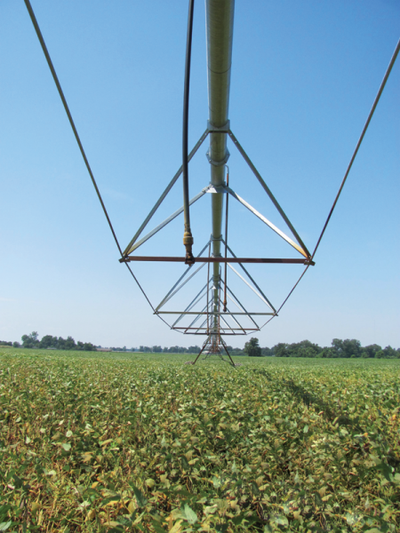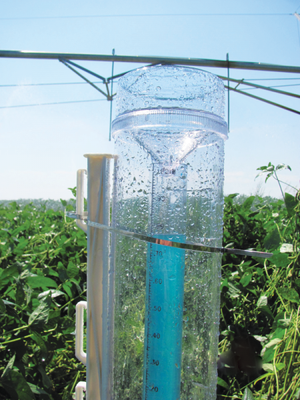
Many center pivot irrigation systems in the Delta are 25 years old or more. Based on their experience with these systems, some growers have a perception that center pivots can’t keep up with crop water demand and are converting to surface irrigation. “It’s a disturbing trend,” says Paul Rodrigue, USDA National Resource Conservation Service supervisory engineer at Grenada, Miss. “These conversions reduce irrigation efficiency and increase demand on already stressed groundwater resources.”

With the shift in crops across the region in recent years, and many center pivot irrigation systems 25 years old older, some growers have a perception that center pivots can’t keep up with demand and are converting to surface irrigation.

PAUL RODRIGUE
“It’s a disturbing trend,” says Paul Rodrigue, USDA National Resource Conservation Service supervisory engineer at Grenada, Miss. “These conversions reduce irrigation efficiency and increase demand on already stressed groundwater resources.”
But NRCS studies of center pivot efficiency were last conducted a quarter-century ago, he notes, and those data lacked relevance for today’s systems and crops.
Ag news delivered daily to your inbox: Subscribe to Delta Farm Press Daily.
“The evaluations that were done 25 years ago tended to show that pivots had the capacity for efficient irrigation of that era’s crops,” Rodrigue says. “But the planned application and the actual application tended to be different. The application rate from the system tended to be higher than most high silt Delta soils could absorb, thus resulting in runoff from where it was intended for the water to be soaked into the ground.

DROPS AND NOZZLES on a modern center pivot system can provide a more accurate, efficient application of water than earlier era systems.
“At that time, the recommendation was for application rates less than 3.5 inches per hour, with lower rates being better. But even at rates lower than 3.5 inches per hour, there was runoff. Approximately 30 percent of the systems had application rates higher than 3.5 inches, and nearly 60 percent had rates greater than 2.5 inches per hour.”
Pivots of that era also tended to run at high system pressures, 75 psi or more, and end guns tended to have higher application rates and lower distribution uniformity than the spans, Rodrigue says.
In cooperation with producer Charlie Craig, the NRCS engineering staff and Coahoma County field office staff, working through the Coahoma Soil and Water Conservation District, evaluated a modern medium pressure system on Craig’s farm at Friar’s Point, Miss., with drops and newer model rotator nozzles.
Measurements included irrigation application under the last two segments, travel speed, and application rate. The end gun was not evaluated.
“The system was set to apply 1-inch of water at a speed setting of 15 percent,” Rodrigue says. “Once it was running, in accordance with safety procedures, we checked to insure there were no stray voltages. Then, collection rain guagues were set out in front of the pivot and the other measurements were made as the system walked across the gauges.”
VIDEO: Furrow irrigation waste a new challenge for Delta farmers
As soon as the application rate measurements were begun, he says, “It was evident that the new model nozzles were providing a much greater wetted diameter than many older nozzles, insuring that application rates would be lower. All the pivot’s drops were directly below the supply pipe. By bringing the nozzles out to the trusses and alternating sides of the pivot for each drop nozzle, the wetted diameter could be increased and the application rate reduced even more.”
While these measurements were being made, the speed of the end tower was also calculated.
System 'right on target'

THIS RAIN GAUGE was used to measure the depth of the application from the center pivot system.
“From these measurements and the measured radius of the last tower, we calculated that the pivot would complete one full circle in 3.1 days,” Rodrigue says. “Once the pivot had sufficiently passed all the catch rain gauges, the system was stopped and application depths read. The average measured application was 0.71 inch. That calculates to a pivot capacity of 0.23 inch per day.
“Traditional irrigation design in the Delta aims for an irrigation rate of 0.25 inches per day, so the system was right on target. With today’s crops and variety potential, and the extremely dry conditions in recent growing seasons, some producers are moving toward an 0.30 inch per day capacity.”
The application rate rain gauge captured 0.77 inches over approximately 22 minutes, he says, giving an average application rate of 2.11 inches per hour.
“That rate is much more in line with the intake rate of many Delta soils,” he says, “and is lower than many of the measurements of 25 years ago. This rate could have been even lower with the alternating truss mounting.”
The pivot was not equipped with a flow meter, he notes, so system efficiency couldn’t be evaluated, “but with the newer nozzle spray patterns and drops, a high efficiency would be expected.”
NRCS provides financial assistance for flow meters.
WATCH: Irrigating farmers reducing water use and saving money
While this evaluation was for only one newer center pivot system, Rodrigue says “It is evident that the new nozzles, new system designs, lower operating pressures, and drops can provide a system with high irrigation efficiency, while meeting crop needs and soil limitations. Furrow diking could also aid water infiltration.
“With the addition of a soil moisture sensor, initiation of pivot irrigation can be more efficiently managed to insure that soil moisture isn’t depleted too much before irrigation begins.”
NRCS offers financial assistance for re-nozzling and adding drops to older systems, he notes, and can also assist in replacing old high pressure pivots with newer low pressure models.
NRCS financial assistance available
“Financial assistance is determined by program emphasis and ranking of applicants,” he says. “Most programs are coordinated with one or more partners — Yazoo-Mississippi Delta Water Management District, Delta Wildlife, Delta F.A.R.M., Mississippi Soil and Water Commission, and local Soil and Water Conservation Districts.
“The first step is to complete an application as your local NRCS county office. The deadline for submitting applications for the first ranking period of Fiscal Year 2014 programs is Nov. 1, 2013.”
The newer data from the Coahoma County center pivot evaluation indicate, Rodrigue says, that “these systems offer high efficiency with lower management inputs that surface irrigation systems. Perhaps it’s time for a center pivot revival in the Delta.”
About the Author(s)
You May Also Like



